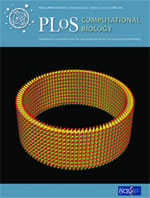
|
{ C O N T E N T S } Volume 9, Issue 2 Mathieu Blanchette Michael Waterman One Year of PLoS CB Education
Column BioLINK and BioCreAtIvE: ISCB Officer and Student Newsletter Cover Image Competition Bioinformatics
Books Upcoming Conferences ACCESS
THE STUDENT COUNCIL NEWSLETTER |
One Year of PLoS Computational Biology
While it is too early to formally assess the impact
of the journal, it is worth reflecting on what has been achieved
in the first year of publication. Twelve monthly issues actually
reflects eighteen months of submissions, given that we have been
considering papers since January of 2005. At the end of June 2006,
631 research articles have been submitted to the journal, 110 have
been published and 64 (48 new submissions and 16 revisions) are
currently under review. We estimate that our acceptance rate is
currently around 30%, increasing in recent months from less than
20% as authors become more familiar with the expectations of the
journal and do not submit papers that have little chance of being
published. We are now publishing about 15 research articles per
month. Accompanying these research articles over the year have been
3 editorials, Interest in the journal can be gauged by the number of people who have signed up to receive an electronic alert of journal contents (eTOC) and by the number of downloads of journal articles. Currently 7,125 people are signed up to receive an eTOC, a number that grows by several hundred each month and since the launch, there has been a total of 262,268 articles download. Two of the top ten papers are in the area of neuroscience and two others form part of the on-going "Ten Rules" series of editorials to aid our less experienced readers. Of the Remainder, one is a perspective discussing team versus individual science and the rest are in the realm of computational molecular biology. Demographics of materials downloaded show North America and Europe account for 60-70% of the usage of the site, but there is significant usage from the developing world, a testament to open access. Overall, we are well on the way to meeting the original editorial goal of the journal -- to establish a high-quality knowledge resource serving a community interested in advancing our understanding of living systems through the use of computational techniques. While reported advances have been predominantly at the molecular level, there is a growing body of work being submitted that covers different levels of biological organization. This reflects our goal to publish great work involving computational analyses at all biological scales. We want to make the connections between researchers who are using conceptually related approaches to tackle diverse issues in biology. What does this first successful year mean to the
Society? There is a healthy and growing relationship between the
two organizations. A number of ISCB Directors are members of the
journal's Editorial Board, Fran Lewitter, the journal's Education
Editor, is part of the ISCB Education Committee which has led to,
for example, solicitation of ISMB tutorials for publication by the
journal. ISCB representatives, including the Chair of the ISCB Publications
Committee, are invited to weekly PLoS teleconferences and PLoS reports
to the ISCB on journal matters relating to the Society. One author
of each accepted paper gets a free one year membership to the Society
and hopefully will renew their membership in later years. Finally,
articles about ISCB activities are a regular feature of the journal.
|

